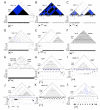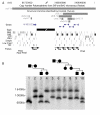Analysis of the largest tandemly repeated DNA families in the human genome
- PMID: 18992157
- PMCID: PMC2588610
- DOI: 10.1186/1471-2164-9-533
Analysis of the largest tandemly repeated DNA families in the human genome
Abstract
Background: Tandemly Repeated DNA represents a large portion of the human genome, and accounts for a significant amount of copy number variation. Here we present a genome wide analysis of the largest tandem repeats found in the human genome sequence.
Results: Using Tandem Repeats Finder (TRF), tandem repeat arrays greater than 10 kb in total size were identified, and classified into simple sequence e.g. GAATG, classical satellites e.g. alpha satellite DNA, and locus specific VNTR arrays. Analysis of these large sequenced regions revealed that several "simple sequence" arrays actually showed complex domain and/or higher order repeat organization. Using additional methods, we further identified a total of 96 additional arrays with tandem repeat units greater than 2 kb (the detection limit of TRF), 53 of which contained genes or repeated exons. The overall size of an array of tandem 12 kb repeats which spanned a gap on chromosome 8 was found to be 600 kb to 1.7 Mbp in size, representing one of the largest non-centromeric arrays characterized. Several novel megasatellite tandem DNA families were observed that are characterized by repeating patterns of interspersed transposable elements that have expanded presumably by unequal crossing over. One of these families is found on 11 different chromosomes in >25 arrays, and represents one of the largest most widespread megasatellite DNA families.
Conclusion: This study represents the most comprehensive genome wide analysis of large tandem repeats in the human genome, and will serve as an important resource towards understanding the organization and copy number variation of these complex DNA families.
Figures





Similar articles
-
[Tandem repeats in rodents genome and their mapping].Tsitologiia. 2015;57(2):102-10. Tsitologiia. 2015. PMID: 26035967 Russian.
-
Human megasatellite DNA RS447: copy-number polymorphisms and interspecies conservation.Genomics. 1998 Nov 15;54(1):39-49. doi: 10.1006/geno.1998.5545. Genomics. 1998. PMID: 9806828
-
Tandemly repeated DNA families in the mouse genome.BMC Genomics. 2011 Oct 28;12:531. doi: 10.1186/1471-2164-12-531. BMC Genomics. 2011. PMID: 22035034 Free PMC article.
-
Complex structure of knobs and centromeric regions in maize chromosomes.Tsitol Genet. 2000 Mar-Apr;34(2):11-5. Tsitol Genet. 2000. PMID: 10857197 Review.
-
Satellite DNAs between selfishness and functionality: structure, genomics and evolution of tandem repeats in centromeric (hetero)chromatin.Gene. 2008 Feb 15;409(1-2):72-82. doi: 10.1016/j.gene.2007.11.013. Epub 2007 Dec 4. Gene. 2008. PMID: 18182173 Review.
Cited by
-
Centromeric transposable elements and epigenetic status drive karyotypic variation in the eastern hoolock gibbon.bioRxiv [Preprint]. 2024 Aug 30:2024.08.29.610280. doi: 10.1101/2024.08.29.610280. bioRxiv. 2024. PMID: 39257810 Free PMC article. Preprint.
-
Oncogenic ETS fusions promote DNA damage and proinflammatory responses via pericentromeric RNAs in extracellular vesicles.J Clin Invest. 2024 Mar 26;134(9):e169470. doi: 10.1172/JCI169470. J Clin Invest. 2024. PMID: 38530366 Free PMC article.
-
Structure of native four-repeat satellite III sequence with non-canonical base interactions.Nucleic Acids Res. 2024 Apr 12;52(6):3390-3405. doi: 10.1093/nar/gkae113. Nucleic Acids Res. 2024. PMID: 38381082 Free PMC article.
-
Comparative analysis of the complete chloroplast genome of Papaveraceae to identify rearrangements within the Corydalis chloroplast genome.PLoS One. 2023 Sep 21;18(9):e0289625. doi: 10.1371/journal.pone.0289625. eCollection 2023. PLoS One. 2023. PMID: 37733832 Free PMC article.
-
The complete sequence of a human Y chromosome.Nature. 2023 Sep;621(7978):344-354. doi: 10.1038/s41586-023-06457-y. Epub 2023 Aug 23. Nature. 2023. PMID: 37612512 Free PMC article.
References
Publication types
MeSH terms
Substances
Grants and funding
LinkOut - more resources
Full Text Sources
Other Literature Sources
Miscellaneous

